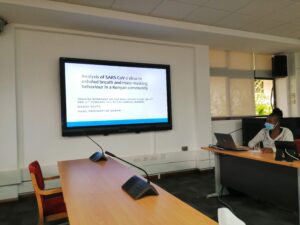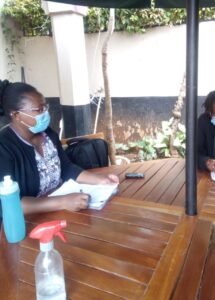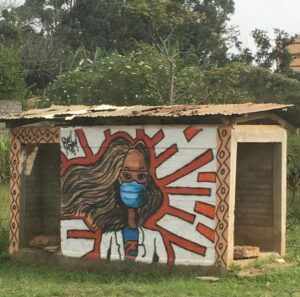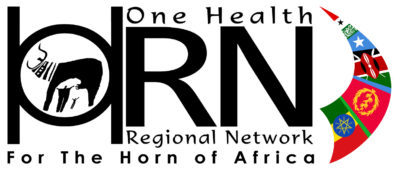
Team Involved in the Project
The multidisciplinary team from Kenya comprising of Lorren Alumasa, Mariah Ngutu, Reuben Mwangi and Stephen Leshan, brought together skills and experience in Public health epidemiology, Anthropology, Molecular biology and Field epidemiology, to undertake a study that would holistically inform efforts to improve population health outcomes from the COVID-19 pandemic in the region. The team continues to work collaboratively with mentors and advisors from relevant disciplines and organizations to not only increase their individual capacity but also produce quality outputs in this One Health research study.
Before the Sandpit
The HORN team put out a call at the beginning of 2020 for project proposals related to COVID-19. A group of individuals from the University of Nairobi, University of Liverpool, ILRI and the ILRI BECA Hub worked out a proposal by examining the surrounding environment. At that time, the law in Kenya had just introduced the legal requirement of wearing a mask covering their mouth and nose as means to reducing transmission of COVID-19. As a team we decided to explore the concept of using face masks as a surveillance tool for COVID-19 within the community in Nairobi.
During the Sandpit
At the Sandpit event the team met their mentors: Professor Nicola Williams (University of Liverpool) Professor Jude Robinson (University of Glasgow) and Professor Andy Morse (University of Liverpool). The team were able to interact with different scientists in different disciplines and were able to formulate and fine tune their project idea with their guidance. On the final day of the event, the team pitched their proposal to the panel and were fortunate enough to be awarded the funds to undertake the project.
After the Sandpit

The team sat together with advisors in Kenya and developed a work plan. Wanting to cover the different social-economic areas within Nairobi, it was decided that the anthropological study and biological sampling will be performed within three areas of Nairobi – Viwandani, Kawangware and Langata – that represent very low, low-and middle-income settings. Research tools – protocols, interview guides, qualitative surveys, questionnaires, and consent forms – were developed and approved. Enumerators, after being trained on qualitative research activities, went out into the community to conduct interviews and surveys with regard COVID-19 and the ways individuals perceive its transmission as well as their habits of wearing masks.
Alongside the ongoing anthropological work, the biological work is slowly under way. After many setbacks, a mask was collected from an individual who tested positive for COVID-19 disease and is being analysed for the presence of the SARS-CoV-2 virus. It was decided to use masks from individuals whose infection status has already been confirmed as either positive or negative through the official RT-PCR test to determine if SARS-CoV-2 can be detected on a face mask, and if so at what levels. Positive controls were required for ‘proof of concept’ before sampling masks from people in the community.
What is the study about?
The study titled ‘Analysis of SARS-C0V-2 virus in exhaled breath and mass-masking behaviour in a Kenyan Community’ combines a biological and anthropological approach to analyse presence of SARS-CoV-2 virus in masks, and determine the potential utility of face masks as a diagnostic tool for non-invasive surveillance of COVID-19, exploring the the knowledge and attitudes that influence mass masking behaviours and practices.

The study sample population is from Nairobi City County, in Kenya, targeting Kawangware and Langata areas to respectively represent low- and middle-income populations. Utilising an exploratory research design, the anthropological approach triangulates up to 50 in-depth interviews, 50 qualitative surveys and up to 20 key informant interviews to gain insights into human behaviours and perspectives towards use of face masks. Data collection, as well as transcription for the qualitative study component, is ongoing to allow for iterative analysis to inform the study objectives. Additionally, given that the population sampling procedures to obtain nasal swabs and/or respiratory secretions for COVID-19 diagnosis are relatively invasive, limiting mass testing practicability, the biological study component will analyse the presence of SARS-CoV-2 virus on masks and determine the potential utility of face masks as a diagnostic tool for non-invasive surveillance of COVID-19.
What are the preliminary Findings?
From the preliminary analysis, two themes summarise the results as illustrated below. The preliminary results are informed by data from Kawangware area, representing the low socio-economic strata:
Theme 1; Knowledge, attitudes and perceptions involved in human response to the COVID-19 pandemic.

The community has general, basic knowledge of COVID-19, as they can talk about its transmission, risk factors as well as prevention measures. There has been mass sensitisation and awareness creation since the first wave of COVID-19 in Kenya and this has informed the knowledge. There are also attitudes and perceptions that manifest in the human response to the ongoing pandemic. While knowledge has been provided, the community perceives the Ministry of Health (MoH) guidelines variously. While some adhere to the guidelines to not get caught on offense, the community is generally fearful of contracting COVID-19 disease, and they express their concern in relation to the possible impact on their health and livelihoods.
Theme 2: Knowledge, attitudes and perceptions influence the behaviour and practices of mass mask wearing in individuals across different socio-economic strata.
While the community is knowledgeable about COVID-19, their behaviour in relation to the MoH protocols are not always followed. The community generally reports adherence to social distancing, hand hygiene and wearing of masks directives. However, in practice, these measures are not followed correctly. For example, community members wear masks when they see a police officer rather than wearing them in public spaces to prevent exposure. There are also perceptions around the use of face masks where the community believes that when you wear a mask in hot weather it is going to make it difficult to breathe properly and that masks are best worn in cold rainy seasons. The community, especially in the low economic setting, will have a mask with them but not wear it correctly, with a majority wearing below the nose.
Challenges during the project
There have been numerous setbacks to the project unfortunately, but we are managing to navigate our way through the difficulties. There was a delay in starting the project owing to the COVID-19 containment measures that initially restricted movements within and around the county, and secondly accessing the subcounty representatives for authorisations to initiate data collection activities within their jurisdictions.
Regarding the biological sampling, we had negotiated and obtained authorisation from the local hospital to have masks from COVID-19 infected individuals delivered to us at ILRI for testing. Unfortunately, all the staff affiliated with the COVID-19 isolation unit went on strike. We are now forging a new relationship with a different hospital to be able to collect masks for validation of our protocol.

